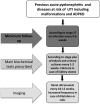A best practice position statement on pregnancy in chronic kidney disease: the Italian Study Group on Kidney and Pregnancy
- PMID: 26988973
- PMCID: PMC5487839
- DOI: 10.1007/s40620-016-0285-6
A best practice position statement on pregnancy in chronic kidney disease: the Italian Study Group on Kidney and Pregnancy
Erratum in
-
Erratum to: A best practice position statement on pregnancy in chronic kidney disease: the Italian Study Group on Kidney and Pregnancy.J Nephrol. 2017 Aug;30(4):619. doi: 10.1007/s40620-017-0418-6. J Nephrol. 2017. PMID: 28620734 Free PMC article. No abstract available.
Abstract
Pregnancy is increasingly undertaken in patients with chronic kidney disease (CKD) and, conversely, CKD is increasingly diagnosed in pregnancy: up to 3 % of pregnancies are estimated to be complicated by CKD. The heterogeneity of CKD (accounting for stage, hypertension and proteinuria) and the rarity of several kidney diseases make risk assessment difficult and therapeutic strategies are often based upon scattered experiences and small series. In this setting, the aim of this position statement of the Kidney and Pregnancy Study Group of the Italian Society of Nephrology is to review the literature, and discuss the experience in the clinical management of CKD in pregnancy. CKD is associated with an increased risk for adverse pregnancy-related outcomes since its early stage, also in the absence of hypertension and proteinuria, thus supporting the need for a multidisciplinary follow-up in all CKD patients. CKD stage, hypertension and proteinuria are interrelated, but they are also independent risk factors for adverse pregnancy-related outcomes. Among the different kidney diseases, patients with glomerulonephritis and immunologic diseases are at higher risk of developing or increasing proteinuria and hypertension, a picture often difficult to differentiate from preeclampsia. The risk is higher in active immunologic diseases, and in those cases that are detected or flare up during pregnancy. Referral to tertiary care centres for multidisciplinary follow-up and tailored approaches are warranted. The risk of maternal death is, almost exclusively, reported in systemic lupus erythematosus and vasculitis, which share with diabetic nephropathy an increased risk for perinatal death of the babies. Conversely, patients with kidney malformation, autosomal-dominant polycystic kidney disease, stone disease, and previous upper urinary tract infections are at higher risk for urinary tract infections, in turn associated with prematurity. No risk for malformations other than those related to familiar urinary tract malformations is reported in CKD patients, with the possible exception of diabetic nephropathy. Risks of worsening of the renal function are differently reported, but are higher in advanced CKD. Strict follow-up is needed, also to identify the best balance between maternal and foetal risks. The need for further multicentre studies is underlined.
Keywords: Chronic kidney disease; Evidence based medicine; Hypertension; Pre-term delivery; Preeclampsia; Pregnancy; Proteinuria.
Conflict of interest statement
Conflict of interest
All authors have no conflict of interest.
Ethical approval
This article does not contain any studies with human participants or animals performed by any of the authors.
Informed consent
For this type of study informed consent is not required.
Figures
References
-
- (1975) Pregnancy and renal disease. Lancet 2(7939):801–802 - PubMed
Publication types
MeSH terms
LinkOut - more resources
Full Text Sources
Other Literature Sources
Medical





